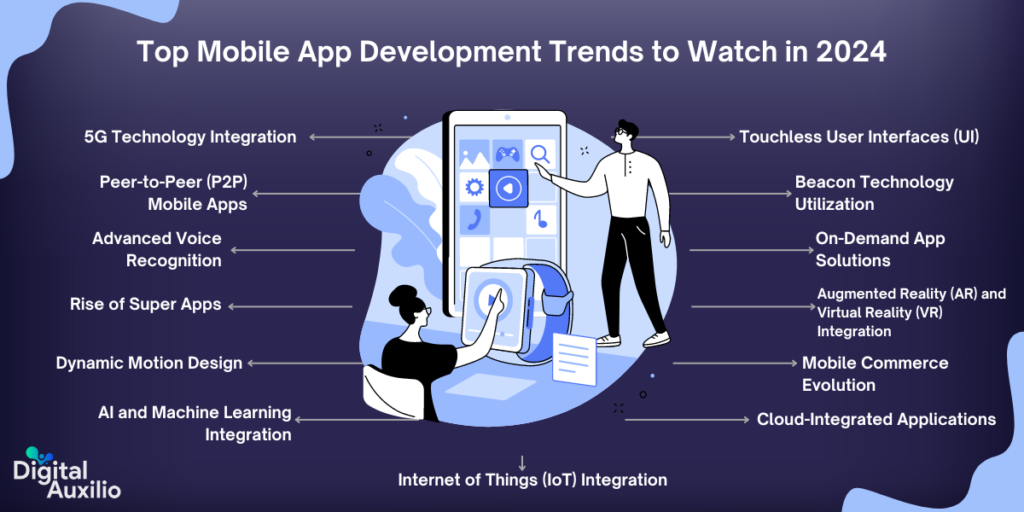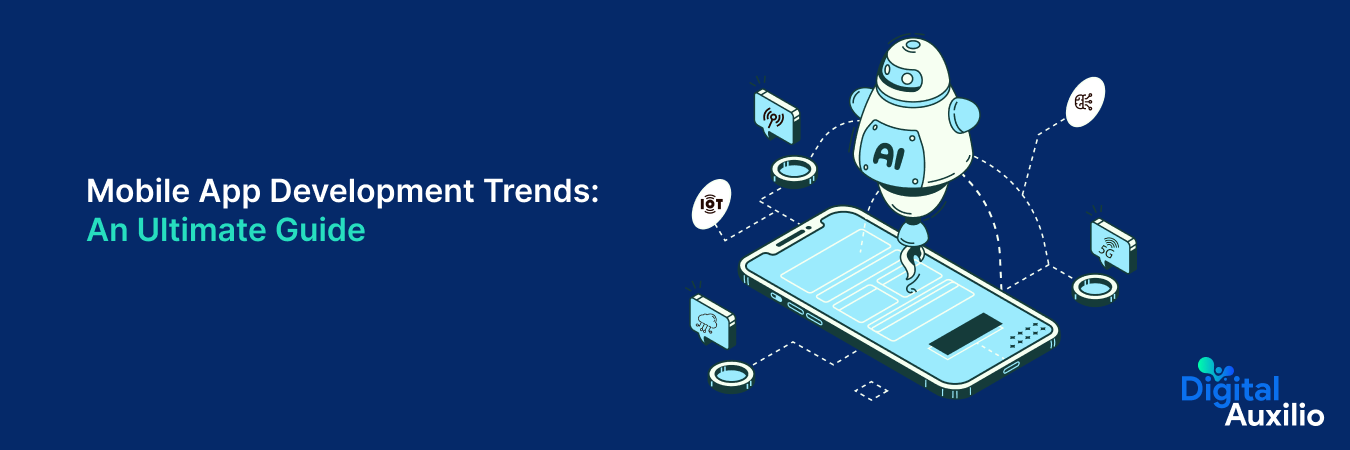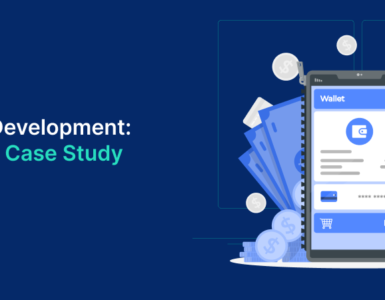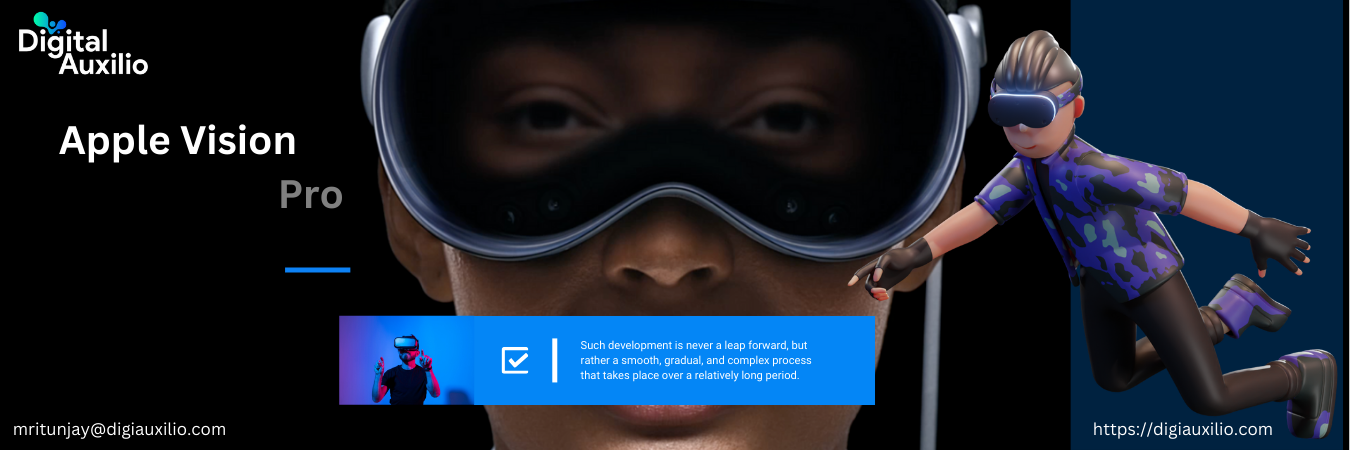In 2024, the landscape of mobile app development continues to evolve rapidly, shaped by emerging technologies and changing user demands. With the global mobile app revenue projected to reach $935 billion by 2023, staying ahead of the curve is essential for developers and businesses alike.
Let’s delve into the top mobile app development trends poised to make waves in 2024, offering insights into how they’re reshaping the industry and unlocking new opportunities for innovation and growth.
What’s Next in Mobile App Development Trends?

As technology continues to evolve at an unprecedented pace, the landscape of mobile applications is constantly shifting, presenting developers with new challenges and opportunities. In this dynamic era, staying ahead of the curve is crucial for creating apps that not only meet but exceed user expectations.
So, what’s next in mobile app development trends? Let’s delve into the exciting developments reshaping the future of mobile applications
1. 5G Technology Integration:
5G technology has been on the rise for the past few years, and in 2024, its integration into mobile app development is set to revolutionize user experiences. With speeds up to 100 times faster than 4G, 5G enables seamless connectivity, ultra-low latency, and enhanced reliability. This advancement opens up a plethora of possibilities for mobile app developers to create more immersive and dynamic applications.
Statistics:
- By 2024, it’s estimated that over 45% of the world’s population will have access to 5G networks, fueling the demand for 5G-enabled applications.
- The global 5G market is projected to reach $700 billion by 2024, indicating a rapid adoption rate and investment in 5G infrastructure.
Example:
- Healthcare app that utilizes 5G technology to enable real-time monitoring of patients’ vital signs remotely. Doctors can receive instant updates and provide timely interventions, improving patient care and outcomes.
2. Peer-to-Peer (P2P) Mobile Apps:
P2P mobile apps leverage decentralized networks to enable direct communication and exchange of resources between users. By eliminating intermediaries, such as centralized servers or platforms, P2P apps enhance privacy, security, and efficiency.
These apps cover a wide range of functionalities, including file sharing, messaging, payments, and collaborative workspaces. Users can securely share files, conduct financial transactions, and communicate without relying on third-party services.
P2P technology is particularly appealing for its resilience and scalability. Since data is distributed across multiple nodes in the network, P2P apps are less vulnerable to single points of failure and can scale more efficiently to accommodate growing user bases.
Statistics:
- According to Statista, the global P2P payment transaction value is projected to reach over $1 trillion by 2023, indicating a significant demand for P2P financial services.
- The decentralized file-sharing platform BitTorrent, one of the pioneers of P2P technology, boasts over 100 million active users worldwide.
Example:
- P2P Payment Apps allow users to transfer money directly to friends, family, or merchants without traditional banking intermediaries, simplifying payment processes.
- Ride-sharing apps such as Uber and Lyft connect passengers directly with drivers, eliminating the need for taxi services and providing more affordable transportation options.
3. Advanced Voice Recognition:
Advanced voice recognition refers to the technology that enables devices to accurately interpret and respond to human speech, often through natural language processing algorithms.
This technology has evolved significantly in recent years, allowing for more seamless interactions between users and their devices or applications.
Statistics:
According to a report by Statista, the global voice recognition market was valued at $6.89 billion in 2021 and is projected to reach $27.16 billion by 2026, with a compound annual growth rate (CAGR) of 31.2% during the forecast period.
Benefits:
- Voice recognition eliminates the need for typing, allowing users to perform tasks hands-free and more quickly.
- Voice-enabled apps cater to users with disabilities or those who prefer auditory interactions, increasing inclusivity.
- Users can accomplish tasks such as sending messages, setting reminders, or searching for information on their mobile devices without needing to stop what they’re doing.
- Voice recognition technology can adapt to individual speech patterns and preferences, providing tailored experiences for users.
- Integrating advanced voice recognition sets mobile apps apart in a crowded market, attracting users seeking cutting-edge features.
Example:
Virtual assistant app equipped with advanced voice recognition technology. Users can simply speak commands or queries, and the app responds with relevant information or executes tasks accordingly.
For instance, a user can say, “Schedule a meeting with John for tomorrow at 10 a.m.,” and the app interprets the command, adds the event to the calendar, and notifies the user. This seamless interaction demonstrates the power and potential of advanced voice recognition in mobile app development.
4. Rise of Super Apps:
Super apps are all-in-one platforms that offer a wide array of services within a single application, ranging from messaging and social networking to financial services, shopping, food delivery, transportation, and more. Originating in Asia, particularly with apps like WeChat in China and Grab in Southeast Asia, super apps have gained popularity worldwide due to their convenience and efficiency in providing multiple services through one platform.
Super apps can be used for many purposes, including:
- Financial services: Bill payments, mobile recharges, investments, insurance selling, credit checks and scoring, loan services, and more
- Communication: Messaging, calling, video, and social media
- Streamlining management: Improving business scalability
- Powerful online presence: Enhancing customer service and rise in profitability
- Access to a wide range of services: Less device storage occupation
Statistics:
- According to research, the global super apps market is expected to reach a valuation of over $500 billion by 2025.
- WeChat, with over 1.2 billion monthly active users, has demonstrated the potential for super apps to dominate large markets.
Example:
- Gojek: Similar to Grab, Gojek started as a ride-hailing service in Indonesia but has expanded to provide a wide range of services including food delivery, shopping, and more.
- Alipay: Developed by Alibaba Group, Alipay offers not only digital payments but also features such as wealth management, insurance, and even social networking.

5. Dynamic Motion Design:
Dynamic motion design leverages animation techniques to bring static elements to life, enhancing storytelling and conveying messages in a more compelling manner. It involves the manipulation of shapes, colors, typography, and imagery to create visually appealing and immersive experiences. Through fluid transitions, kinetic typography, animated illustrations, and interactive elements, motion design adds depth and dimension to visual content, making it more engaging and memorable for viewers.
For instance, a weather app may use subtle animations to depict changing weather conditions, enhancing the user’s understanding and enjoyment of the app.
6. AI and Machine Learning Integration:
AI and ML algorithms enable mobile apps to learn from user interactions and behaviors, allowing for personalized recommendations, content filtering, and predictive analytics. This level of customization enhances user experiences and increases user engagement.
Mobile apps can leverage AI-powered chatbots and virtual assistants to provide instant customer support, answer queries, and automate routine tasks, such as appointment scheduling or order tracking.
ML algorithms enable mobile apps to identify patterns and trends within data, leading to more accurate predictions and insights. This capability is invaluable across various industries, including finance, healthcare, marketing, and gaming.
Statistics:
- The global market size of AI in 2023 is US $207 billion and is projected to rise to almost US $740 billion in 2030, with mobile apps playing a significant role in this growth.
- The global ML market was valued at $15.44 billion in 2021, and is expected to reach $209.91 billion by 2029, with a CAGR of 38.8%.
Example:
Mobile apps like Netflix and Spotify use AI and machine learning algorithms to analyze user preferences and behavior, recommending personalized content such as movies, TV shows, or music playlists.
7. Touchless User Interfaces (UI):
Touchless user interfaces have gained momentum in 2024 due to the growing emphasis on hygiene and touchless interactions in response to the COVID-19 pandemic. These interfaces utilize technologies such as gesture recognition, voice commands, proximity sensors, Eye tracking, Screen takeover, Live AR, and Reactive display to enable users to interact with mobile apps without physical contact, reducing the risk of germ transmission and enhancing user convenience.
- Gesture Recognition: Mobile apps are integrating gesture recognition technology to interpret hand movements and gestures, allowing users to navigate, select options, and interact with content without touching the screen.
- Voice Commands: Voice-enabled UIs enable users to control mobile apps using voice commands, facilitating hands-free interactions for tasks such as making calls, sending messages, and accessing information.
- Proximity Sensors: Proximity sensors detect the presence and movement of users near the device, enabling touchless interactions such as automatic screen wake-up, proximity-based gestures, and object recognition
Example:
A mobile banking app could implement touchless user interfaces by allowing users to authenticate their identity using facial recognition technology, navigate through account details using gesture controls, and perform transactions using voice commands, offering a secure and convenient banking experience without requiring physical touch.
8. Beacon Technology Utilization:
Beacon technology involves the deployment of small Bluetooth-enabled devices known as beacons in physical locations to transmit signals that can be detected by mobile devices.
In 2024, mobile app developers are increasingly leveraging beacon technology to enhance location-based services, proximity marketing, and indoor navigation within mobile apps. Beacons enable precise, real-time interaction between mobile apps and physical environments, offering personalized experiences and valuable insights to users and businesses alike.
Here are some ways beacon technology is used:
- Location-Based Services: Mobile apps use beacon technology to deliver location-specific content, services, and notifications to users based on their proximity to beacon-equipped locations, enhancing user engagement and providing contextually relevant experiences.
- Proximity Marketing: Businesses utilize beacon technology to deliver targeted promotions, discounts, and personalized offers to customers’ mobile devices when they are in close proximity to beacon-enabled stores or venues, driving foot traffic and sales.
- Indoor Navigation: Beacons installed in indoor environments such as airports, shopping malls, and museums enable mobile apps to provide accurate indoor navigation and wayfinding solutions, helping users navigate complex spaces and discover points of interest.
Statistics:
- According to a research report, the global smart beacon market generated more than $3 billion in 2020 and is expected to reach $103.94 billion by 2030, growing at a CAGR of 37.70% from 2021 to 2030.
- The global beacon market size was USD 1.36 billion in 2018 and is projected to reach USD 31.61 billion by 2026, reflecting a CAGR of 48.9% during the forecast period
Example:
A retail mobile app could leverage beacon technology to send push notifications to nearby users about ongoing sales or promotions as they enter the store, guide shoppers to specific product aisles using indoor navigation features, and offer personalized recommendations based on their browsing history and location within the store.
9. On-Demand App Solutions:
On-demand app solutions continue to be a prominent trend in mobile app development, catering to the growing demand for convenience, efficiency, and instant access to goods and services.
In 2024, mobile app developers are focusing on creating on-demand platforms that connect users with a wide range of services, including food delivery, transportation, home services, healthcare, and more, enabling seamless transactions and real-time service delivery at the tap of a button.
Here are some types of on-demand apps:
1. On-demand equipment apps – Help you grow your business by allowing you to list items you sell and receive orders from customers
2. On-demand babysitter apps – Allow babysitters to create their profiles and parents to search and hire them
3. On-demand travel apps – Enable guests to book flights, hotels, and rental cars, and track their itineraries
4. Healthcare apps- Involve an expertise database management system that helps facilitate the movement of data
5. On-demand taxi apps – A convenient way to digitize your current transportation business
Statistics:
- The on-demand services app market value is expected to reach $335 billion by 2025.
- The demand for on-demand applications is growing in the post-pandemic era, catering to more than 22.4 million consumers every year.
- 86.5 million people in the US use on-demand apps.
- 42% of the US adult population has used an on-demand service, and 22% have offered services in on-demand service.
- Almost 60% of customers are ready to pay the additional cost for same-day delivery.
Example:
Uber is an on-demand app that connects users with a service provider, who then checks the request and accepts it. Payment is authorized, the provider delivers the service, and the customer confirms the delivery.
10. Augmented Reality (AR) and Virtual Reality (VR) Integration:
Augmented Reality (AR) and Virtual Reality (VR) integration in mobile app development continues to expand in 2024, offering immersive and interactive experiences that blend the digital and physical worlds. AR overlays digital content onto the real-world environment, while VR creates entirely virtual environments, both enhancing user engagement and providing innovative solutions across various industries.
Here are some use cases for AR and VR in mobile apps:
- Gaming – AR gaming apps, like Pokémon GO, overlay virtual elements onto the real world, creating immersive experiences.
- Education – AR apps can make learning more interactive and immersive by bringing complex concepts to life. For example, AR can help students explore historical places, dive into the ocean, or study complex structures.
- Retail – AR apps can revolutionize shopping experiences, allowing customers to try products virtually before purchasing.
- Healthcare – AR apps can assist surgeons by providing real-time, enhanced visuals. AR can also help doctors access multiple simulations of a particular medical condition and help reduce the number of errors in prognosis and patient visits.
- Real estate – AR apps can offer virtual tours of properties, enabling a more realistic view of spaces without physical visits.
Statistics:
- The AR and VR market is expected to generate $38.6 billion in revenue in 2024, and $58.1 billion by 2028.
- The AR software market is expected to reach $13 billion in 2024, and $77.5 billion by 2028.
- The United States is the leading revenue generator in the AR and VR market, with a projected $10,260 million in 2024.
- The number of AR and VR market users is expected to reach 3.674 million by 2028.
- 61% of consumers prefer retailers with AR experiences.
- AR product experiences are 200% more engaging than their non-AR equivalent.
- 75% of the global population and almost 100% of the smartphone user population are expected to turn into AR frequent users by 2025.
Example:
A furniture retail app could integrate AR technology to allow users to visualize how furniture pieces would look in their own homes using their smartphone camera, enabling them to virtually place and interact with virtual furniture models in their living space before making a purchase decision.

11. Mobile Commerce Evolution:
Mobile commerce, or m-commerce, continues to evolve in 2024, reshaping the way consumers shop and interact with brands through their mobile devices. With the proliferation of smartphones and the increasing adoption of mobile payment solutions, mobile commerce is becoming the preferred method for online shopping, driving innovation in mobile app development and transforming the retail landscape.
Statistics:
According to a November 2023 EMARKETER forecast, mobile commerce (m-commerce) sales in the US in 2024 will reach $558.29 billion, which is 7.4% of total retail sales. m-commerce is also expected to make up 44.6% of total US retail e-commerce sales in 2024
Here are some other 2024 m-commerce statistics:
- Active shoppers: There will be an average of 283 million active m-commerce shoppers in the US in 2024
- Market size: The m-commerce market is predicted to hit $710 billion by the end of 2025
- Global share: The share of m-commerce in e-commerce is expected to cross 70% globally by 2024
Example:
Uber Eats is a prime example of mobile commerce. Users can browse through a variety of restaurants, place orders, and pay for their meals directly through the mobile app. The entire transaction, from selection to payment, occurs seamlessly within the app, making it a convenient and efficient way to order food on the go.
12. Cloud-Integrated Applications:
Cloud-integrated applications have emerged as a powerful solution in mobile app development, offering a myriad of benefits for both users and developers alike. While cloud technology initially served as a hosting service, its evolution has paved the way for innovative approaches to app development.
Cloud-integrated apps operate directly on the cloud infrastructure, alleviating the burden on internal smartphone memory and enhancing overall performance and reliability.
Users no longer need to worry about their mobile devices crashing due to memory constraints when using these apps, as the heavy lifting is offloaded to the cloud.
Both users and app developers stand to gain significant advantages from cloud integration:
- Quicker Development: Cloud integration streamlines the app development process, reducing development time and complexity. Developers can leverage cloud-based tools and resources to build and deploy apps more efficiently.
- Cost Savings: By utilizing cloud infrastructure, developers can minimize upfront infrastructure costs associated with hosting and maintaining servers. This cost-effective approach allows developers to allocate resources more efficiently and focus on innovation.
- Seamless Access: Users can seamlessly access cloud-integrated apps without the need for lengthy downloads and installations. This frictionless experience enhances user satisfaction and encourages engagement with the app.
Statistics:
- Multi-cloud strategy: 81% of companies have a multi-cloud strategy in place or in development.
- Public cloud use: 89% of businesses use multi-cloud solutions, with 80% using hybrid clouds, 7% using multiple public clouds, and 2% using multiple private clouds.
- Public cloud storage: 48% of businesses use the public cloud to store their data.
Example:
Consider a photo editing app that integrates cloud storage for storing and processing high-resolution images. Users can seamlessly edit photos on their mobile devices, with the heavy computational tasks such as rendering and saving handled by the cloud servers. This not only conserves device storage but also ensures consistent performance regardless of the device’s specifications.
13. Internet of Things (IoT) Integration:
IoT integration is the process of connecting sensors and objects with one another and with applications and databases. Once connected, you can implement end-to-end automation that helps you make full use of your equipment. Mobile apps equipped with sensors, cameras, and beacons play a crucial role in analyzing real-time customer data.
IoT has created a way to secure apps by protecting consumer identities and ensuring data encryption. For example, IoT-based apps allow consumers and vehicle manufacturers to analyze their performance, such as fuel consumption, pollution checks, overall car health, road conditions, traffic, and driving behavior.
Here are some statistics about the growth of the Internet of Things (IoT) in mobile app development:
- The global IoT market was valued at $544.38 billion in 2022, and is expected to grow to $3,352.97 billion by 2030.
- The number of IoT-connected devices is expected to reach 30.9 billion units by 2025, up from 13.8 billion in 2021.
- The global IoT in the retail market is predicted to experience a compound annual growth rate of 28.4% from 2023 to 2030
In Conclusion
Staying ahead in the dynamic landscape of mobile app development trends is crucial for businesses aiming to thrive in 2024. Embracing cutting-edge technologies can enhance user experiences and drive engagement.
To navigate these advancements effectively, partnering with a reputable mobile app development company that offers comprehensive services is essential.
Whether it’s to develop a new app or revamp an existing one, hiring skilled mobile app developers is key. For tailored solutions and expert guidance, contact us at Digital Auxilio today to unlock the full potential of your mobile app endeavors.
FAQs
1. What are the potential benefits of adopting these mobile app development trends?
Adopting these trends can lead to enhanced user engagement, improved app performance, increased security, streamlined development processes, and a competitive edge in the market. Businesses can leverage these trends to deliver innovative and value-driven mobile experiences to their customers.
2. What are the challenges associated with adopting these mobile app development trends?
Challenges may include technical complexities, security concerns, privacy issues, compatibility with existing systems, and the need for skilled talent to implement and maintain these advanced technologies effectively.















Add comment